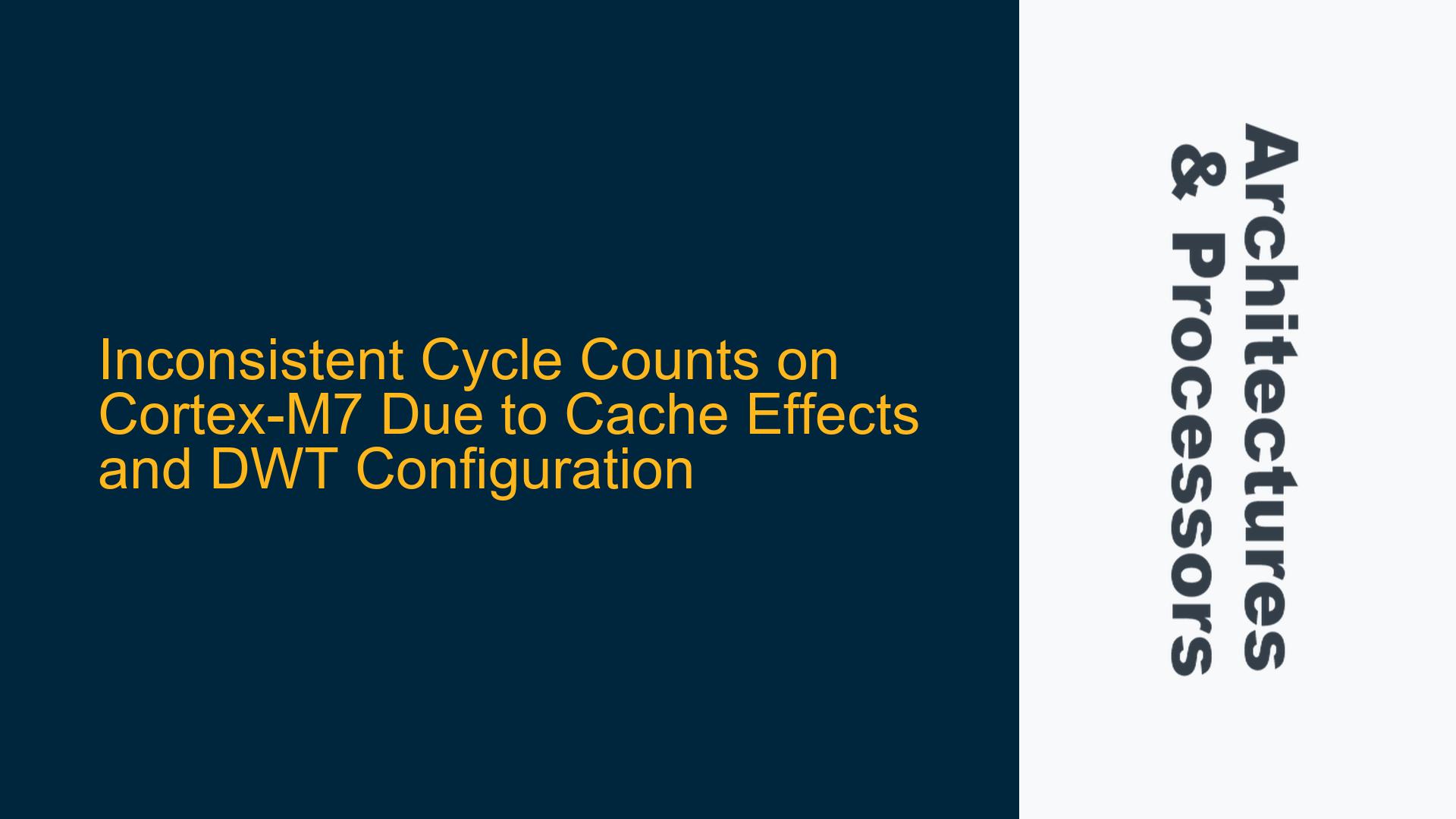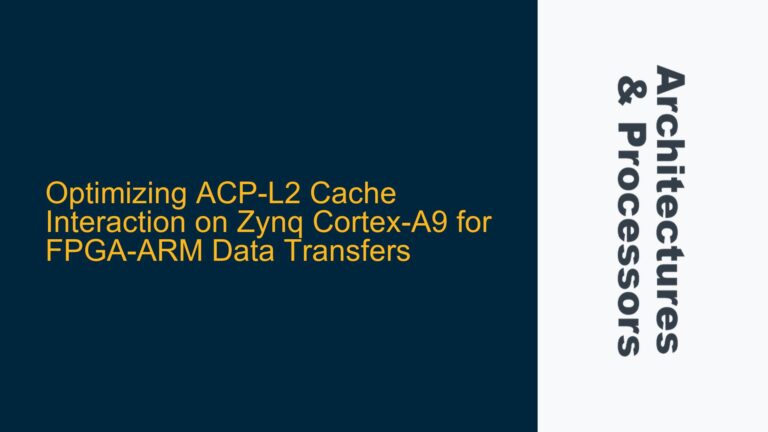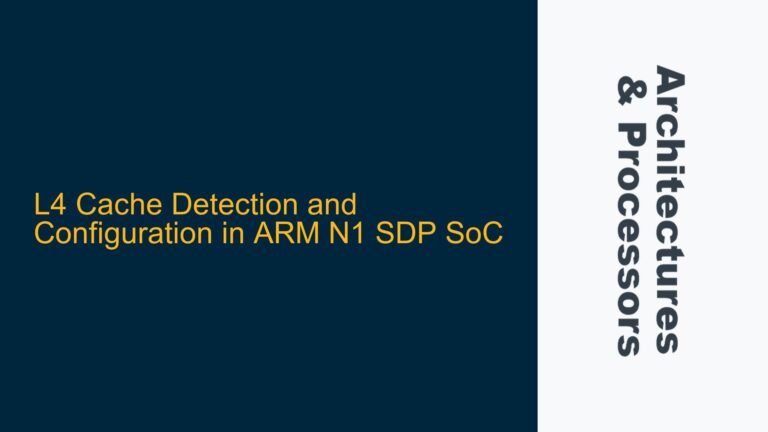ARM Cortex-M7 Cycle Count Variability During CMSIS-DSP Function Execution
The Cortex-M7 processor, known for its high performance and advanced features such as caches and branch prediction, can exhibit variability in cycle counts when executing functions like arm_abs_q7 from the CMSIS-DSP library. This variability is particularly noticeable when using the Data Watchpoint and Trace (DWT) unit to measure cycle counts. The DWT unit provides a cycle counter (DWT_CYCCNT) that can be used to profile code execution. However, the presence of caches, branch prediction, and other microarchitectural features can lead to inconsistent cycle counts across multiple runs of the same function.
The Cortex-M7’s instruction and data caches are designed to improve performance by reducing memory access latency. However, these caches introduce non-deterministic behavior in cycle count measurements, especially when the same function is executed repeatedly. The first execution of a function may result in cache misses, leading to higher cycle counts, while subsequent executions benefit from cache hits, resulting in lower cycle counts. Additionally, the Cortex-M7’s branch predictor can further influence cycle counts by speculatively executing instructions, which may or may not align with the actual execution path.
The DWT cycle counter itself is a 32-bit register that increments with each processor cycle. To use it for profiling, the counter must be enabled by setting the DWT_CONTROL register and configuring the SCB_DEMCR register to enable the DWT unit. However, improper configuration or timing of these registers can lead to inaccurate cycle count measurements. For example, if the DWT_CYCCNT register is not reset before starting the measurement, the accumulated cycle count from previous operations may skew the results.
Cache Behavior, Branch Prediction, and DWT Configuration Impact on Cycle Counts
The Cortex-M7’s caches and branch prediction mechanisms are the primary contributors to cycle count variability. The instruction cache (I-cache) and data cache (D-cache) are designed to store frequently accessed instructions and data, respectively. When a function is executed for the first time, the instructions and data may not be present in the caches, resulting in cache misses. These misses require additional cycles to fetch the necessary instructions and data from memory, leading to higher cycle counts. Subsequent executions of the same function are likely to benefit from cache hits, reducing the number of cycles required for execution.
Branch prediction is another factor that can influence cycle counts. The Cortex-M7 uses a dynamic branch predictor to guess the outcome of conditional branches and speculatively execute instructions along the predicted path. If the prediction is correct, the processor avoids pipeline stalls, resulting in lower cycle counts. However, if the prediction is incorrect, the processor must flush the pipeline and fetch instructions from the correct path, increasing the cycle count.
The configuration of the DWT unit also plays a critical role in cycle count accuracy. The DWT_CYCCNT register must be reset to zero before starting a measurement to ensure that the cycle count reflects only the execution of the target function. Additionally, the DWT_CONTROL register must be configured correctly to enable the cycle counter. If the counter is not enabled or is improperly configured, the cycle count measurements may be inaccurate or inconsistent.
Mitigating Cycle Count Variability Through Cache Management and DWT Optimization
To obtain consistent and accurate cycle count measurements on the Cortex-M7, it is essential to address the effects of caches, branch prediction, and DWT configuration. One approach is to manage the caches explicitly by invalidating or cleaning them before executing the target function. This ensures that the function execution starts with a clean cache state, reducing variability due to cache hits and misses. The following steps outline a method for managing caches and optimizing DWT configuration:
-
Cache Invalidation: Before executing the target function, invalidate the I-cache and D-cache to ensure that the function’s instructions and data are fetched from memory. This can be done using the
SCB_InvalidateICacheandSCB_InvalidateDCachefunctions provided by the CMSIS library. Invalidation ensures that the first execution of the function is not influenced by residual data in the caches. -
Branch Prediction Disabling: To eliminate variability due to branch prediction, consider disabling the branch predictor during cycle count measurements. This can be achieved by setting the
BPbit in theCPACRregister to disable the branch predictor. Note that this may increase cycle counts due to pipeline stalls but ensures deterministic behavior. -
DWT Configuration: Ensure that the DWT cycle counter is properly configured and reset before starting a measurement. The following code snippet demonstrates the correct configuration:
volatile uint32_t *DWT_CYCCNT = (uint32_t *)0xE0001004; volatile uint32_t *DWT_CONTROL = (uint32_t *)0xE0001000; volatile uint32_t *SCB_DEMCR = (uint32_t *)0xE000EDFC; *SCB_DEMCR |= 0x01000000; // Enable DWT unit *DWT_CYCCNT = 0; // Reset cycle counter *DWT_CONTROL |= 1; // Enable cycle counter algorithm(); // Execute the target function uint32_t cycle_count = *DWT_CYCCNT; // Read cycle count printf("Cycle count: %lu\n", cycle_count); -
Repeatable Measurements: To account for any residual variability, perform multiple measurements of the target function and calculate the average cycle count. This helps smooth out any minor inconsistencies caused by microarchitectural features.
-
Memory Barrier Usage: Insert memory barriers before and after the target function to ensure that all memory operations are completed before starting and stopping the cycle counter. This prevents out-of-order execution from affecting the cycle count measurements.
By implementing these steps, developers can achieve more consistent and accurate cycle count measurements on the Cortex-M7, enabling better performance analysis and optimization of embedded systems. Understanding the interplay between caches, branch prediction, and DWT configuration is crucial for obtaining reliable results in performance-critical applications.






